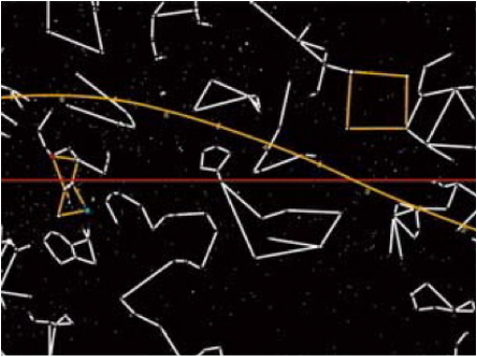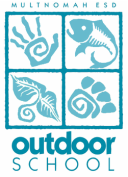StarLab Presentations |
|
|
The basic StarLab presentation includes a look at the constellations using the identification system developed by H. A. Rey. Once the students are familiar with the basic shapes, they can then see the night sky shown with over 3,000 stars, complete with an accurate depiction of the Milky Way based on photos by Dr. Axel Mellinger. Students can find the constellations in this star field, and experience the rotation of the earth and the changing of the seasons.
Additional enhancements of the basic program can include a discussion of moon phases and the position of the moon in relation to the star field, a look at the classic Greek depictions of the constellations we know today, as well as African constellations as seen by the Zulu, Xhosa, Sotho, Tswana, Egyptian, and others or the Chinese asterisms of the Five Palaces originating in 15,600 B.C.E. The Solar System presentation features a depiction of our galaxy and an exploration of the celestial bodies surrounding our sun and the relationships between them. Students can compare the relative sizes of the planets and their relative distances while learning facts about the planets and their moons. |
H.A. Rey Constellations
|
This cylinder features 48 constellations using the identification system developed by H.A. Rey. The ecliptic and celestial equator are also shown in this depiction.
Constellations included in this cylinder: Circumpolar: Cassiopeia, Cepheus, Draco, Ursa Major, & Ursa Minor. Zodiac: Aquarius, Aries, Cancer, Capricornus, Gemini, Leo, Libra, Pisces, Sagittarius, Scorpius, Taurus, & Virgo. Other: Andromeda, Aquila, Ara, Auriga, Bootes & Canes Venatici, Canis Major, Canis Minor, Centaurus, Cetus, Columba, Corvus, Crux, Cygnus, Eridanus, Hercules, Hydra, Hydrus, Lepus, Lupus, Musca, Octans, Ophiuchus, Orion, Pavo, Pegasus, Perseus, Phoenix, Piscis Austrinus, Triangulum Australe, & Tucana. |
Suggested follow-up questions and activities for the classroom:
|
Star Field
|
This cylinder features the stars as they would be seen with no light pollution. The digitally-produced projection can simulate the night sky at any time, season, or location.
Starfield features included in this cylinder: Over 3,000 stars; the brightest stars are individually lensed, resulting in bright pinpoint images; accurate star locations; full color depictions of Betelgeuse, Rigel, Antares, Spica, Arcturus, Capella, and Pollux; blockable aperatures for showing the sun or phases of the moon; a precise depiction of the Milky Way based on Dr. Alex Mellinger’s photographs. |
Suggested follow-up questions and activities for the classroom:
|
Greek Mythology
|
This cylinder is an excellent introductory tool for exploring classical Greek folklore. There are 45 Greek constellations depicted on this cylinder over a background of stars.
Greek constellations included in this cylinder: Andromeda, Aquarius, Aquila, Aries, Auriga, Bootes, Cancer, Canis Major, Canis Minor, Capricornus, Cassiopeia, Centaurus, Cepheus, Cetus, Corona Borealis, Corvus, Crater, Cygnus, Delphinus, Draco, Equuleus, Eridanus, Gemini, Hercules, Hydra, Leo, Lepus, Libra, Lyra, Ophuichus, Orion, Pegasus, Perseus, Phoenix, Pisces, Pisces Australis, Sagitta, Sagittarius, Scorpius, Southern Cross, Taurus, Triangulum, Ursa Major, Ursa Minor, and Virgo. |
Suggested follow-up questions and activities for the classroom:
|
African Mythology
|
This cylinder shows constellations as seen by several different African cultures. Many of the constellations mark important agricultural and seasonal events.
African constellations included in this cylinder:
|
Suggested follow-up questions and activities for the classroom:
|
Chinese Mythology
|
This cylinder depicts aspects of life in China 5,000-10,000 years ago. Significant constellations were monitored, and decisions and ceremonies were based on celestial events and predictions. Because these predictions sometimes had political ramifications, astronomical observations were considered “classified.” Most of the patterns shown on this cylinder are “asterisms,” or smaller parts of much larger constellations. In general, these asterisms are simple reminders of tasks or places rather than complex stories.
Chinese constellations included in this cylinder: Horn (Spica), Heavenly Fields (Virgo), Great Horn (Arcturus), The Emperor’s Mat (Bootes), Celestial Wheel Spokes (Centaurus), South Gate of the Sky (Alpha & Beta Centauri), Great Fire (Antares), Manuring Tray, Southern Bushel, & Emperor’s Black Banner (Sagittarius), The Autumn Marketplace & Footbridge Across the Silver Rivers (various stars), Money String (Corona Borealis), Tortoise (Corona Australis), Weaving Star (Vega), Oxen Driver (Altair & Aquila), Pearls & Ornate Dresses (Capricornus), Coach House (Cygnus), Funeral Mound of the Sun (Equulas & Aquarius), Roof of the House (Aquarius & Pegasus), Four Pillars of Heaven, Thunder and Lightning, Clouds and Rain, & Temple of Light (Pegasus), Awakening Serpent (Lacerta & Cygnus), Eight Evil Chiefs & Outer Enclosure (Pisces), General of the Northern Countries (Formalhaut), Light Infantry Soldiers (Sculptor), Celestial Marshes & Celestial Granary (Cetus), Celestial Boat, Great Trench, Eight Sacks of Grain, & Heaped-Up Corpses (Perseus), Two Hunting Nets or Celestial Snares (Taurus & The Pleiades), Five Chariots & Tie-Up Posts (Auriga), Supreme Commander Tsan (Orion), Well & Celestial Vessel (Gemini), Northern River, Two Love Butterflies, & Yin-Yang Symbol (Castor & Pollux), Celestial Jackal (Sirius), Bow and Arrow (Canis Major), Old God Who Shoots Celestial Dog With Bow and Arrow & Willow (Hydra), Water Flowing (Leo), Chariot (Corvus), Northern Bushel or the Balance of Jade (Ursa Major), Imperial Prime Minister and the Crown Prince (Ursa Minor), Sky Emperor and His Wife (Polaris), Bridge of Kings & Whip (Cassiopeia), Chariot & Inner Throne of the Five Emperors (Cepheus), Container to Hold the Woven Garments & Flail (Draco). |
Suggested follow-up questions and activities for the classroom:
|
Solar System
|
This cylinder features our galaxy and solar system. The artistic representation of the Milky Way Galaxy is based on recent astronomical color studies. The Solar System is represented using two different scales, as well as other celestial bodies found in the neighborhood of our sun.
Solar System information included in this cylinder: The planets in order of distance from the sun, planet sizes relative to each other and to the sun, planetary distances relative to each other and to the sun; information for each planet includes the distance from the sun in millions of kilometers and in astronomical units (a.u.), the diameter of the planet in kilometers, rotation, orbital period, mean surface temperature, and major moons. |
Suggested follow-up questions and activities for the classroom:
|



